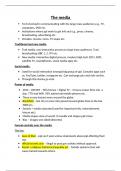Lecture notes
A level Sociology - The media
Full overview and detailed explanations of the whole topic - the media. Includes key sociologists for every topic listed in the media. Examples , explanations and evaluations included. Easy to memorise and understand for last minute revision for AQA A LEVELS all topics and sub topics inclu...
[Show more]



